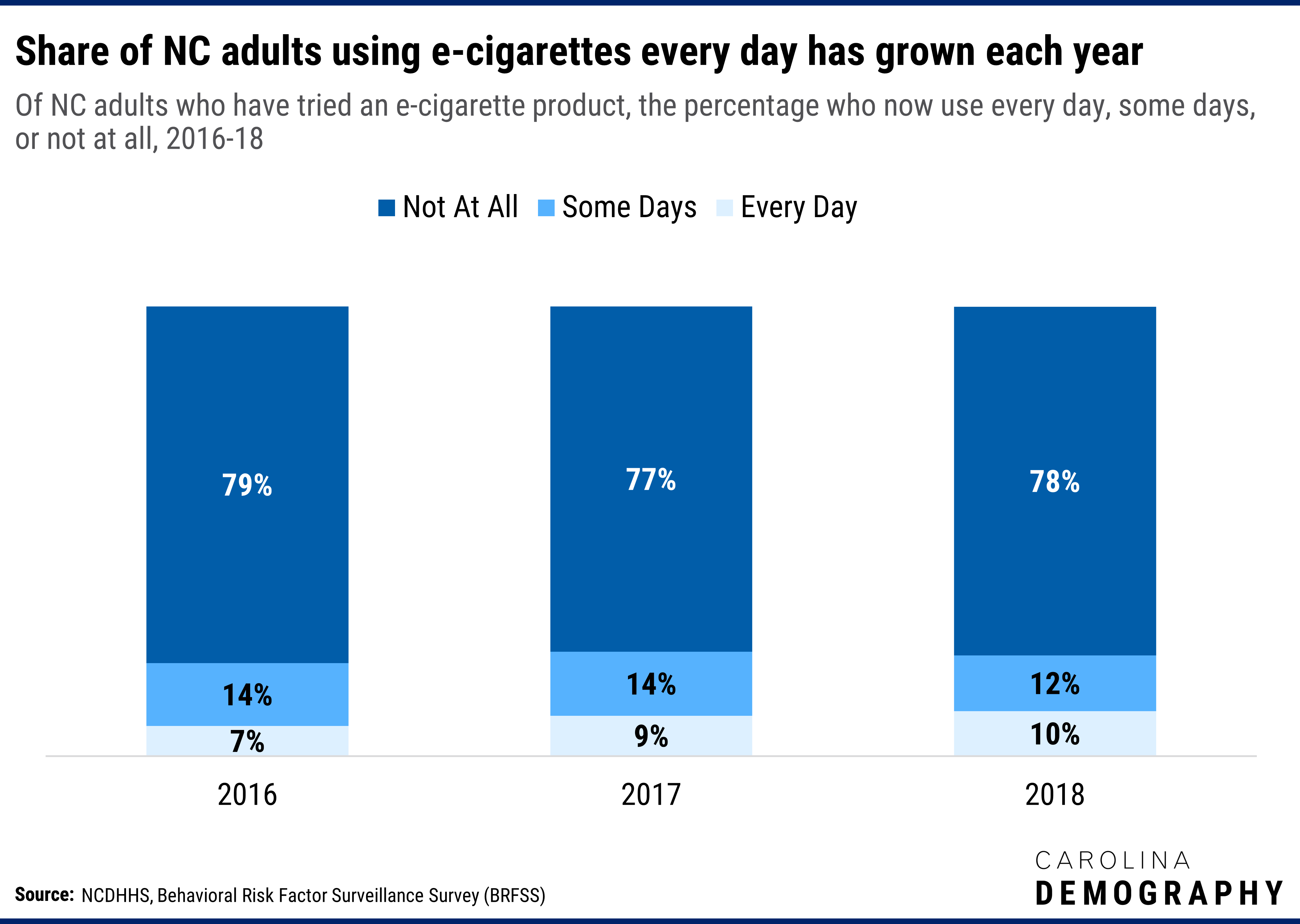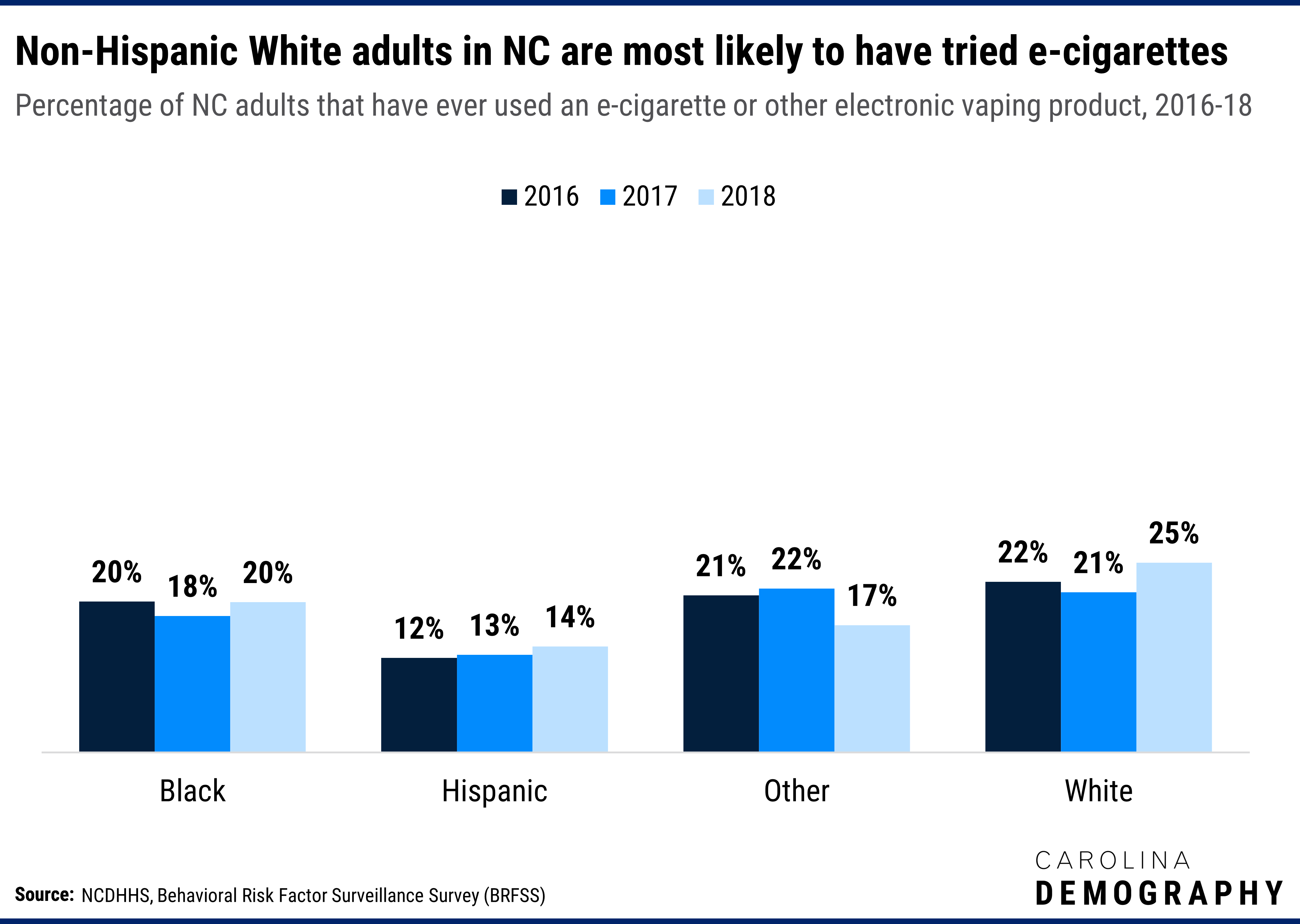Looking at E-Cigarette Usage in North Carolina

E-Cigarette Usage for North Carolina Residents
Across the United States, cigarette smoking is now at an all-time low – dropping from 42% of adults in 1965 to 14% in 2017. This is a major victory for public health officials, but challenges remain.
Historically, e-cigarettes have been embraced by existing tobacco smokers as a reportedly safer alternative to smoking and eventual cessation device. More recently, however, new users – particularly high school students – have taken up e-cigarettes without any previous tobacco consumption.
This trend prompted a federal law to shift the legal age of purchase from 18 to 21 for all tobacco-related products, in hopes of reducing the climb in teen and young adult users.
This has become even more important due to COVID-19. Researchers at Stanford University found that young people who vaped were five to seven times more likely to be infected than those who did not use e-cigarettes. According to one researcher, “…youth who are using vapes or are dual using [e-cigarettes and cigarettes] are at elevated risk, and it’s not just a small increase in risk; it’s a big one.”
Tracking e-cigarette usage in North Carolina
Because e-cigarettes are relatively new, data is limited on usage. The Behavioral Risk Factor Surveillance Survey (BRFSS) from the Center for Disease Control only began tracking this metric in 2016.
As of 2018, 22.6% of North Carolinians that participated in the survey said they had tried an e-cigarette or vaping product at least once. This is up slightly from 21.2% in 2016.
Those who answered “Yes” to using an e-cigarette at least once were then asked if they now used e-cigarettes daily, some days, or not at all. The share answering “Not at all” declined 1.8 percentage points, from 79.3% in 2016 to 77.5% in 2018.
More alarming is the jump in daily users: 6.7% in 2016 to 10% in 2018 – a rise of 3.3 percentage points.

E-cigarette usage across demographic groups
Survey participants aged 18-34 were the most likely to have tried e-cigarette or vaping products at least once in their life (40% in 2018). While data is limited on daily usage for all age groups, the latest results from 2018 indicate that 11.8% of individuals aged 18-34 who have tried e-cigarettes now use every day.
Following similar trends as smoking, men are more likely to have tried e-cigarettes than women – 25.2% vs. 20.4% in 2018 – and are more likely to be daily or semi-regular users.
Across racial and ethnic groups, non-Hispanic Whites are most likely to have tried using e-cigarettes:
*Note: Data for American Indians did not meet statistical reliability standards and was omitted.

For many demographic groups, e-cigarette usage appears to be on the rise. It is important for health authorities to continue their campaign to limit use of e-cigarettes, especially as data suggests that usage makes one more susceptible to contracting COVID-19.
Need help understanding population change and its impacts on your community or business? Carolina Demography offers demographic research tailored to your needs.
Contact us today for a free initial consultation.
Contact UsCategories: Health & Environment

The Center for Women’s Health Research (CWHR) at the University of North Carolina School of Medicine released the 12th edition of our North Carolina Women’s Health Report Card on May 9, 2022. This document is a progress report on the…

Dr. Krista Perreira is a health economist who studies disparities in health, education, and economic well-being. In collaboration with the Urban Institute, she recently co-led a study funded by the Kate B. Reynolds Foundation to study barriers to access to…

Our material helped the NC Local News Lab Fund better understand and then prioritize their funding to better serve existing and future grant recipients in North Carolina. The North Carolina Local News Lab Fund was established in 2017 to strengthen…
Your support is critical to our mission of measuring, understanding, and predicting population change and its impact. Donate to Carolina Demography today.